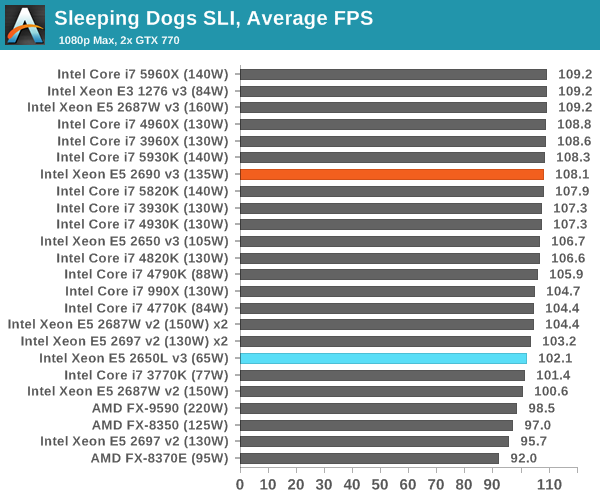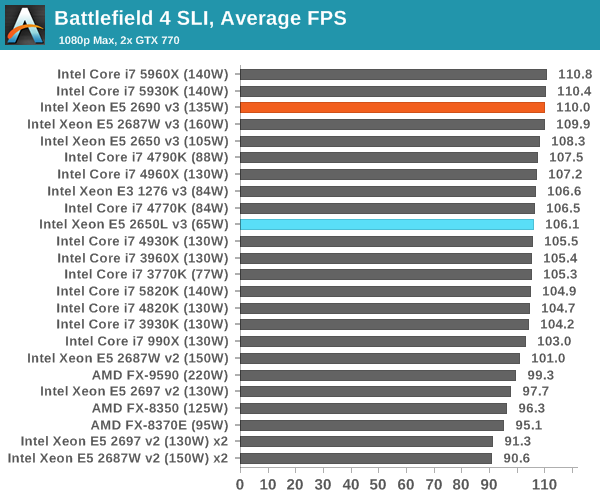Intel Haswell-EP Xeon 12 Core Review: E5-2650L V3 and E5-2690 V3
by Ian Cutress on November 6, 2014 9:00 AM EST- Posted in
- CPUs
- IT Computing
- Intel
- Xeon
- Enterprise
- LGA2011-3
- Haswell EP
Gaming Benchmarks
While the last thought on the minds of most Xeon users is related to gaming, we frequently get requests to test gaming performance on Xeons. As a result we strap the Xeon to a regular consumer level motherboard that can support them and add in one or two GPUs to see how they perform and if more cores makes a difference over the drop in frequency. Unfortunately due to the orientation of the PCIe slots on the 2P board, we were unable to test the dual E5-2650L v3 configuration.
F1 2013
First up is F1 2013 by Codemasters. I am a big Formula 1 fan in my spare time, and nothing makes me happier than carving up the field in a Caterham, waving to the Red Bulls as I drive by (because I play on easy and take shortcuts). F1 2013 uses the EGO Engine, and like other Codemasters games ends up being very playable on old hardware quite easily. In order to beef up the benchmark a bit, we devised the following scenario for the benchmark mode: one lap of Spa-Francorchamps in the heavy wet, the benchmark follows Jenson Button in the McLaren who starts on the grid in 22nd place, with the field made up of 11 Williams cars, 5 Marussia and 5 Caterham in that order. This puts emphasis on the CPU to handle the AI in the wet, and allows for a good amount of overtaking during the automated benchmark. We test at 1920x1080 on Ultra graphical settings.

Bioshock Infinite
Bioshock Infinite was Zero Punctuation’s Game of the Year for 2013, uses the Unreal Engine 3, and is designed to scale with both cores and graphical prowess. We test the benchmark using the Adrenaline benchmark tool and the Xtreme (1920x1080, Maximum) performance setting, noting down the average frame rates and the minimum frame rates.

Tomb Raider
The next benchmark in our test is Tomb Raider. Tomb Raider is an AMD optimized game, lauded for its use of TressFX creating dynamic hair to increase the immersion in game. Tomb Raider uses a modified version of the Crystal Engine, and enjoys raw horsepower. We test the benchmark using the Adrenaline benchmark tool and the Xtreme (1920x1080, Maximum) performance setting, noting down the average frame rates and the minimum frame rates.

Sleeping Dogs
Sleeping Dogs is a benchmarking wet dream – a highly complex benchmark that can bring the toughest setup and high resolutions down into single figures. Having an extreme SSAO setting can do that, but at the right settings Sleeping Dogs is highly playable and enjoyable. We run the basic benchmark program laid out in the Adrenaline benchmark tool, and the Xtreme (1920x1080, Maximum) performance setting, noting down the average frame rates and the minimum frame rates.

Battlefield 4
The EA/DICE series that has taken countless hours of my life away is back for another iteration, using the Frostbite 3 engine. AMD is also piling its resources into BF4 with the new Mantle API for developers, designed to cut the time required for the CPU to dispatch commands to the graphical sub-system. For our test we use the in-game benchmarking tools and record the frame time for the first ~70 seconds of the Tashgar single player mission, which is an on-rails generation of and rendering of objects and textures. We test at 1920x1080 at Ultra settings.
















52 Comments
View All Comments
colinstu - Thursday, November 6, 2014 - link
that's what I was thinking tooFlunk - Thursday, November 6, 2014 - link
It's a bit annoying, that despite it's ability to produce 16-core behemoths, Intel is still only setting 4-core chips in it's mainstream line. There is plenty of room for product differentiation here, but I guess lack of competition means Intel doesn't have any reason to add cores.tim851 - Thursday, November 6, 2014 - link
> but I guess lack of competition means Intel doesn't have any reason to add coresYup.
That's why it's lame to be a fanboy. You want many companies to succeed in a market with good product substitution.
SuperVeloce - Friday, November 7, 2014 - link
Mainstream line does not need more than 4 HT cores. If you need more, haswell-E and haswell-EP are available to you. 5820k is low cost if you want or have need for a x99 chipset and ddr4.Black Obsidian - Friday, November 7, 2014 - link
Yeah, it's not lack of competition, it's lack of any good reason whatsoever to sell >4 cores into the mainstream market. Only a vanishingly tiny percentage of users can even fully utilize 4 cores; for those who can (and could use more), there exists both the enthusiast desktop and Xeon workstation segments.Wolfpup - Thursday, November 6, 2014 - link
This is insane. You can now have TWELVE Haswell cores FOR LESS POWER THAN MY 2004 PRESCOTT Pentium 4!That is freaking amazing.
And while it's hopeless that I'll ever get to run something like this (probably even for a sever at work, much less in a desktop PC like I'd like), it's still freaking amazing to see what's possible :-D
Shadowmaster625 - Thursday, November 6, 2014 - link
In Bioshock, why do several more expensive and newer chips only produce half the minimum framrates vs a 3770K????TeXWiller - Thursday, November 6, 2014 - link
What should be common to all those processors with lower results in Bioshock minimum frame rates is the added latency at the L3 or memory controller/system agent level. An easy test to see how much it can effect test results is to drop the frequency of the memory controller. The effect can be as much as half the performance for a 200 MHz drop, depending on the test (SPECviewperf 12 for me).SanX - Thursday, November 6, 2014 - link
Apple A8 chip costs $18Mediatek 8-core chip costs $12
Intel 8-core chip costs $600-2000
Monopoly rulezz
Guspaz - Thursday, November 6, 2014 - link
You're comparing different parts with different performance sold in different volumes to different markets for different purposes. How many A8 chips would it take to get the performance of an 8-core Haswell chip? 32? 64? The dollars-per-MIPS might not be as different as their overall costs.